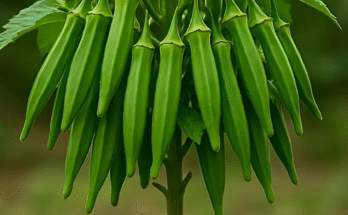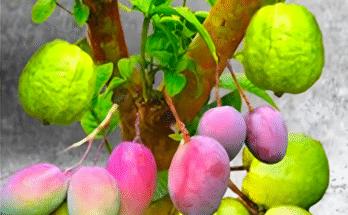How to Propagate and Grow Black Sapote Fruit Trees Using Cutting Techniques
Black sapote, often called the “chocolate pudding fruit,” is a tropical delicacy loved for its sweet, rich, cocoa-like flavor and creamy texture. Many gardeners believe that black sapote can only be grown from seeds, but propagation from cuttings is also possible with the right method, patience, and proper care. Using cutting techniques allows you to clone the mother tree, ensuring the new plant retains desirable traits such as fruit size, flavor, and faster production. This guide will walk you through a simple and effective process to propagate and grow black sapote fruit trees using stem cuttings.
1. Understanding Black Sapote and Why Cutting Propagation Works
Black sapote (Diospyros digyna) belongs to the persimmon family. While seed-growing is common, it does not guarantee that the new plant will resemble the parent tree. Seeds often produce trees with different fruit characteristics and longer maturity times.
However, cutting propagation creates a true-to-type clone, meaning the genetic qualities of the mother plant—such as sweetness, fruit color, texture, and productivity—are perfectly preserved.
Although black sapote wood is somewhat challenging to root compared to softer tropical species, using the right technique, proper rooting hormones, and ideal environmental conditions greatly increases your success.
2. Choosing the Perfect Cutting for Propagation
The success of propagating black sapote begins with selecting the correct cutting. Follow these guidelines:
➤ Choose semi-hardwood cuttings
These are neither too soft nor fully woody. Semi-hardwood cuttings root much better and are ideal for black sapote.
➤ Length and thickness
- Cuttings should be 15–20 cm long.
- Each cutting should be about the thickness of a pencil or slightly thicker.
➤ Leaf structure
Leave 2–3 leaves at the top. Remove the bottom leaves to reduce water loss and prevent rotting.
➤ Cut from a healthy, productive mother tree
Trees that already produce high-quality fruit will pass on their traits to the new plant.
3. Preparing the Cutting for Successful Rooting
Once your cuttings are selected, preparation is key. Here is how to prepare them:
Step 1: Make a clean angled cut
Cut the base of the stem at a 45-degree angle to increase rooting surface area.
Step 2: Lightly wound the lower bark
Gently scrape 1–2 cm of bark on one side of the stem. This exposes the cambium layer and promotes root growth.
Step 3: Apply rooting hormone
This is one of the most important steps because black sapote wood can be slow to root.
Use:
- Powdered rooting hormone,
- Or gel-based rooting hormone.
Dip the wounded part of the cutting into the hormone. Rooting hormone dramatically increases your chance of success.
4. Preparing the Best Growing Medium for Black Sapote Cuttings
Cuttings must be placed in a well-draining, sterile growing medium. A heavy soil will suffocate the cutting and cause rot. Use any of these mixtures:
Recommended Growing Media
- 50% coarse sand + 50% coco peat
- Perlite + peat moss (1:1 ratio)
- Coco coir + pumice
The key is lightweight, airy, and moisture-retentive but not soggy.
Before planting, lightly moisten the medium—not too wet, not too dry.
5. Planting the Cuttings
To plant black sapote cuttings, follow these steps:
- Make a small hole deep enough to bury 5–7 cm of the stem.
- Insert the cutting carefully without rubbing off the rooting hormone.
- Firm the soil around the cutting to remove air pockets.
- Place all planted cuttings inside a humid environment.
6. Creating the Perfect Humidity Chamber
High humidity is crucial for root formation. Without humidity, the cutting will dry out quickly.
Two Easy Methods
➤ Method 1: Mini Greenhouse
- Place cuttings in pots.
- Cover with a transparent plastic bag.
- Use sticks to keep plastic from touching the leaves.
➤ Method 2: Propagation Box
Use a clear plastic container with a lid.
This locks in moisture and maintains consistent humidity.
Humidity goal: 70–90%
Temperature: 25–32°C (ideal for tropical rooting)
Place the cuttings in bright, indirect light—not direct sunlight.
7. Maintaining and Caring for the Cuttings
To successfully root black sapote cuttings, you must maintain ideal conditions:
Watering
Keep the medium slightly moist. Overwatering causes rot; underwatering causes drying.
Air circulation
Open the cover for 5–10 minutes each day to let in fresh air and prevent mold growth.
Patience
Black sapote can take 6–10 weeks to root. Some cuttings may take longer. Be patient and do not disturb the soil.
8. Checking for Root Development
After 6–8 weeks, gently tug on the cutting. If it resists, roots have formed.
Look for:
- New leaf growth
- A firm, stable stem
- No signs of rot or wilting
Once roots are well-developed, transplant the young black sapote plant into a larger pot with rich soil.
9. Transplanting and Growing the Young Tree
Move the rooted cutting into a pot containing:
- Topsoil
- Compost
- Sand for drainage
Place the plant in partial sunlight for the first 1–2 weeks, then slowly introduce it to full sun.
Watering
Water regularly, but do not let the soil stay soggy.
Fertilizing
Use:
- Organic compost
- A balanced fertilizer (NPK 10-10-10)
10. Final Tips for a Healthy Black Sapote Tree
- Plant outdoors once the tree is strong and at least 40–50 cm tall.
- Choose a sunny location with well-draining soil.
- Avoid waterlogging.
- Mulch to maintain moisture and control weeds.
With consistent care, your black sapote grown from cuttings can begin producing fruit in 2–4 years, faster than seed-grown trees.



